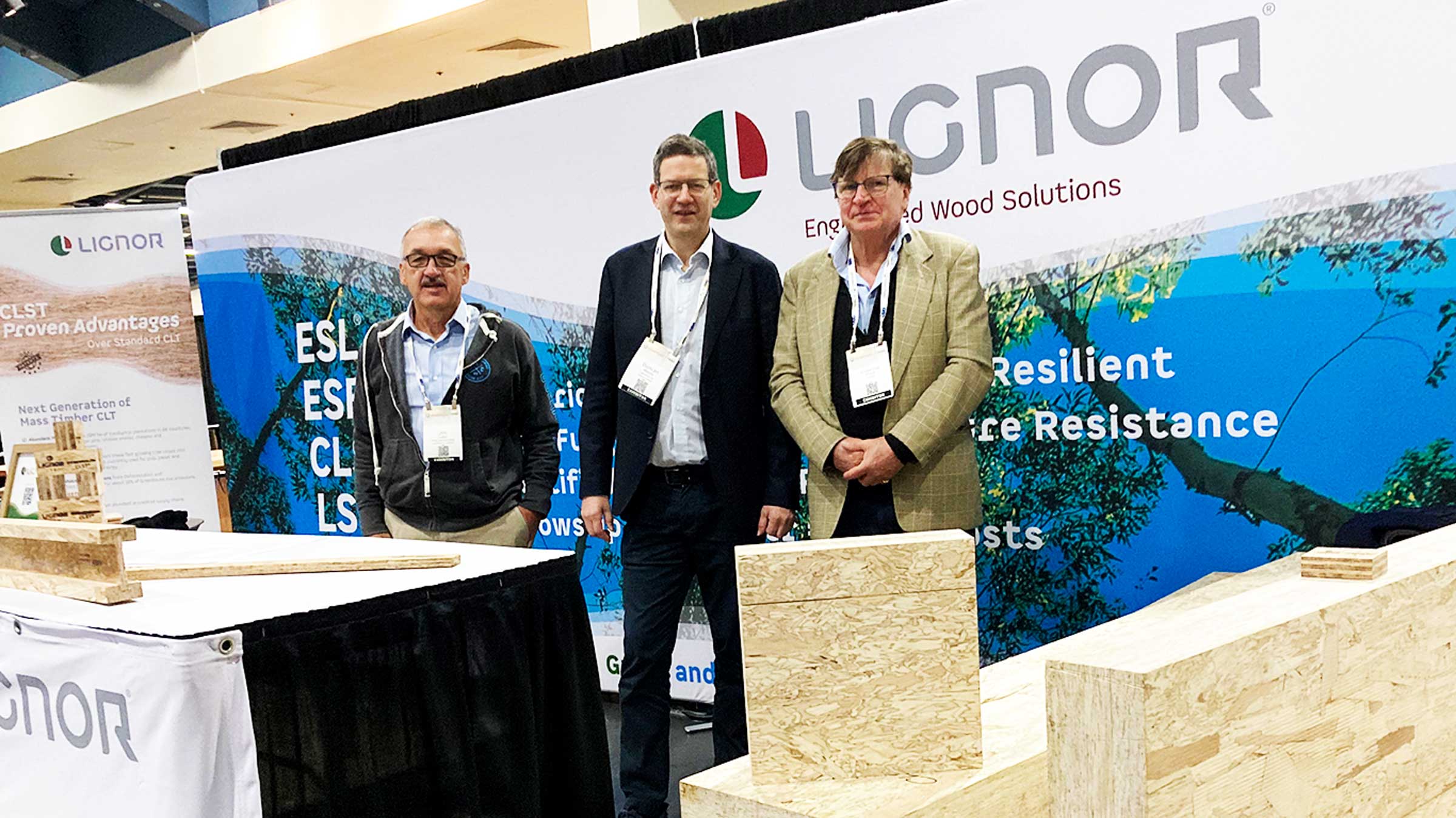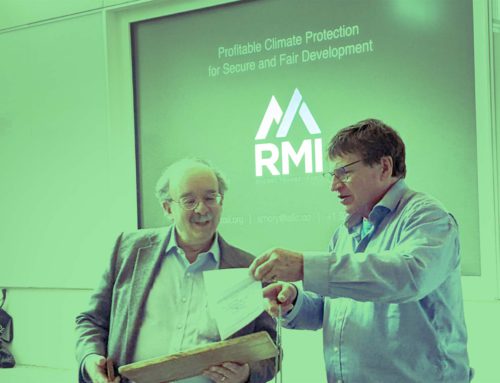Lignor Team above: Jim Lake, Duncan Mayes, Graeme Black CEO > Contact.

Lignor was proud to be present at this year’s Greenbuild build and Industrialised Wood Based Construction (IWBC) conference and Exhibition in San Francisco. The full scale CLST® elements and beams impressed both architects and construction companies from all over North America and beyond. Subsequent social media coverage of the event has gone global with very high levels of interest. The common theme of interest from all the visitors to our booth was the highly efficient use of pulp wood and its conversion into super strong PRG320 approved structural products.
“Leadtime Headaches”
A number of current users of CLT expressed frustration at lead times over CLT with an apparent lack of availability in North America and a high reliance on imports from Europe which carries a large carbon footprint especially when transporting to the West Coast markets such as California where the highest percentage of Mass timber projects have been so far. What became very apparent was that the interest and demand of Mass Timber is growing fast in North America but there are concerns about how much the business can grow against the back drop of diminishing supply long term for structural saw logs. We were able to advise the interested parties that Lignor is looking at setting up a first of its kind patented Lignor Cross Laminated Strand Timber (CLST®) plant up the USA together with a very experienced engineered wood plant developer.
There was a strong interest to take the new Lignor product into their projects and portfolio once the plant is up and running.
Many could see Lignor’s patented technology has huge potential in reducing the carbon footprint of buildings and deforestation and land degradation and continue to lock away the carbon for decades instead of converting the material into traditional paper products. The construction industry and impacts of reduction in global biomass are two primary drivers of mankind’s greenhouse gas emissions, c 39% and 18% respectively. Substituting wood for conventional building materials reduces emissions by 69%.
Many commended the marketing euphoria Tesla has made on the car transport sector, which is much smaller emitter of greenhouse gases, yet it depends on how the electricity or batteries are made in the first place. Some 20% of US electricity is generated from renewables. Attendees were excited Lignor can lock up carbon faster with the use of short rotation plantation wood with its unique patented technology.
“7yrs vs. 70!”
Lignor has succeeded in producing a 7-year-old low density Eucalyptus container floorboard stronger than a 70-year-old tropical rainforest timber board traditionally used in containers. Lignor container floor boards have passed the necessary tests with global leader Maersk, after 7 years’ collaboration, with the sector having a global market of almost 1.3Mm3 pa. Currently nearly half of this timber supply is from tropical rainforest converted at a very low conversion percentage eg 25% which is quite unacceptable. Bamboo is increasingly penetrating this market segment, but it is labour intensive and difficult to scale and achieve a consistent product performance.
“Carbon Sink”
Through using new Mass Timber products like the Lignor CLST®, we can make buildings long term carbon sinks rather than into pulp for paper or much worse burning for energy. Wood Construction the Greatest Chance. The World needs to continuously plant new trees to re-balance the biomass to man-made materials balance and the great thing is there is already over 20 M ha of Eucalyptus in 86 countries and mega tonnes of other faster growing woods such as aspen around the world. Both these juvenile tree crops grow up to 4.5 times faster than conventional forests.

Lignor recently got our Aspen CLST® tested to PRG320. According to an Independent Expert’s (Tom Rines of Northland Consulting) Lignor’s Aspen CLST® is up to 3 times stronger in the major strength direction and up to 4 to 5 times stronger in the minor strength direction than some CLT’s.
“Save Money”
Furthermore, CLT must rely on expensive sawmill logs of which they convert to sawn lumber which after all the processing steps leads to a log to CLT yield of roughly 30%. Admittedly the residue fibres are not wasted but end up in short life span products or at worst burnt for energy. Conversely Lignor’s CLST® process uses pulp logs which are far more abundant globally and also lower in cost compared to saw logs and can achieve an initial conversion rate of up to 70% of the log into useful structural product.
The remainder used to generate heat for most of the manufacturing process or for landscaping purposes. A virtuous circle. Moreover, as we treat every strand holistically before it’s pressed into the lamina, we can make the whole product termite, fungal, moisture and fire resistant unlike CLT which must rely on an envelope treatment to achieve such properties.
CLT is projected to grow at 15% through to 2028, but with a lack of saw logs and global increase in demand the Lignor CLST® seem set to make a real sustainable impact to the future built environment helping tackle climate change.
So to summarise:
CLST®
Cross Laminated Strand Timber
1)
This unique Timber is made by pressing LSL laminae together to form a very high strength product both in cross-sectional and longitudinal directions.
2)
CLST® is best suited for wood panel-based construction.
3)
It differs from other solid wood panels, such as Cross Laminated Timber (CLT), in that it:
a. Can be machined in any plane or direction as demonstrated to the excited attendees who were lucky enough to receive one of the CLST® pens given out at the booth.
b. Has a lower tendency to delaminate in fire like CLT planks as the laminae are much bigger than planks with the Aspen CLST® Passing a two-hour test with no problem. Eucalyptus not treated for fire retardant has a char rate 38% lower than pine often used in CLT.
c. Lower stick count and natural variability in feedstock leads to easier set up and higher predictable performance.
d. Can be made resistant to fire, rot, termite and fungal attack throughout the entire matrix of the product rather than just being envelope treated to increase its longevity.
4)
Has been tested to meet the PRG320 Standard for CLT based on Aspen with compelling superior performance and far more efficient conversion rate.
5)
Ability to use abundant, faster growing and lower cost pulp logs compared to diminishing and expensive saw logs, which are urgently needed for traditional light frame construction.
6)
Buildings are responsible for c 38% of man-made Greenhouse gas emissions. These can be reduced by up to 75% if high embodied energy products such as steel and concrete are replaced by Engineered Wood Products.
7)
Lignor is thus well positioned to help abate Climate Change using fast growing fully accredited sustainable tree crops to help sequestrate carbon for decades. Currently much of these tree crops are used for pulp, paper or worse burnt for energy.
8)
That is why Lignor has trademarked Green and REDD®+







